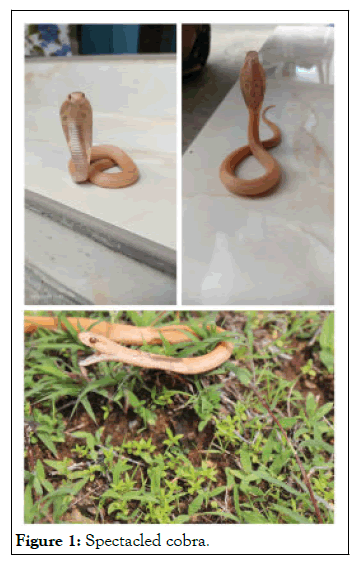Entomology, Ornithology & Herpetology: Current Research
Open Access
ISSN: 2161-0983
ISSN: 2161-0983
Short Communication - (2023)Volume 12, Issue 1
In reptiles, seven different basic types of color aberrations were described: Albinism, axanthism, erythrism, hypo melanism, leucism, melanism and piebaldism. Albinism is a congenital depigmentation syndrome characterized by the absence of melanin. It is caused due to genetic inheritance. Melanin production in the skin can be blocked by errors at any of several steps in the pathway of melano synthesis, mostly (but not entirely) as a result of autosomal recessive mutations.
The absence of pigments, makes the individuals distinguishable from others. Albinos often are stillborn or malformed and have low survival rates, easily eliminating them from populations. Almost all vertebrate species on earth exhibit albinism, yet despite this ominous condition, wild animals continue to exist in the wild. Since carolus linnaeus in the mid-1700’ s, albinistic animals have been documented and researched. Estimates of the ratio of albinism in wild vertebrates vary from 1:10,000 to 1:30,000.
Elapid; Absence of pigment; Amelanism; Rare documentation; Binocellate cobra
Coloration is crucial for inter and intraspecific communication, sexual selection, and predator avoidance through crypsis, mimicry, or aposematism [1-3]. A hereditary condition referred as albinism is distinguished by a full or partial lack of pigmentation in the skin, hair, scales, feathers, or eyes. Leucism and albinism have both been reported in reptiles. Individuals are typically categorised as true albinos, partial albinos, or leucistic based on their albinistic features, which might vary. Albino animals exhibit both favourable and unfavourable reactions to their albinistic traits [4,5].
Due to the absence of integumentary and retinal pigmentation, albinism causes the body to be white or yellowish and 5the eyes to be red. The best way to identify albinism is by abnormal skin, hair, feather, scale, or eye colour. Pinkish-yellow complexion and reddish eyes are characteristics of albinos where condition affects the melanophores in both their skin and eyes (full amelanism) (Spadola and Insacco 2010 Albinos have sun sensitive skin, which can hinder growth and frequently result in eyesight impairment. Albinos usually appear as unique individuals in nature. Albinism can be found in all animals, including reptiles, however it is uncommon in snakes, especially in adults, in the wild.
Albino cobras (Naja naja) are among the top ten rarest albino animals on earth. The spectacled cobra (Naja naja) is a large (maximum total length>2 m), venomous, primarily diurnal elapid found throughout the Indian subcontinent, where it lives in a variety of habitats including forests and urban areas from sea level to 2,000 m.a.s.l [6-8]. The spectacled cobra has a double eye shaped mark on its hood, while the monocled and andaman cobras have a single eye shaped mark. The spectacled cobra (Naja naja) is another name for the Indian cobra (Naja naja) (Figure 1).

Figure 1: Spectacled cobra.
At about 1200 hrs on 9th July 2022 (19.9061859, 83.1576965) the third author, received a rescue call regarding a juvenile snake have entered inside kitchen. After arriving to the spot, third author identified the snake is an albino juvenile common cobra.
After the documentation the snake was relocated at nearby forest safely. A brief awareness session was conducted at the site of rescue in order to drive conservation and safety measures amongst the local people.
We are thankful to earth crusaders organization for their social awareness on wildlife from grass root level and helping in drafting of this manuscript.
The authors declare no conflict of interest during the preparation of this article.
Citation: Mohalik RK, Samal A, Sahu B, Pandey S. Rescue and Documentation of an Albino juvenile Common Cobra, Naja naja (Linnaeus 1758) from Bhawanipatna, Kalahandi, Odisha. Entomol Ornithol Herpetol. 12:301.
Received: 06-Aug-2022, Manuscript No. EOHCR-22-18721; Editor assigned: 08-Aug-2022, Pre QC No. EOHCR-22-18721; Reviewed: 22-Aug-2022, QC No. EOHCR-22-18721; Revised: 02-Jan-2023, Manuscript No. EOHCR-22-18721; Published: 09-Jan-2023 , DOI: 10.35248/2161-0983.22.12.301
Copyright: © 2023 Mohalik RK, et al. This is an open-access article distributed under the terms of the Creative Commons Attribution License, which permits unrestricted use, distribution, and reproduction in any medium, provided the original author and source are credited.